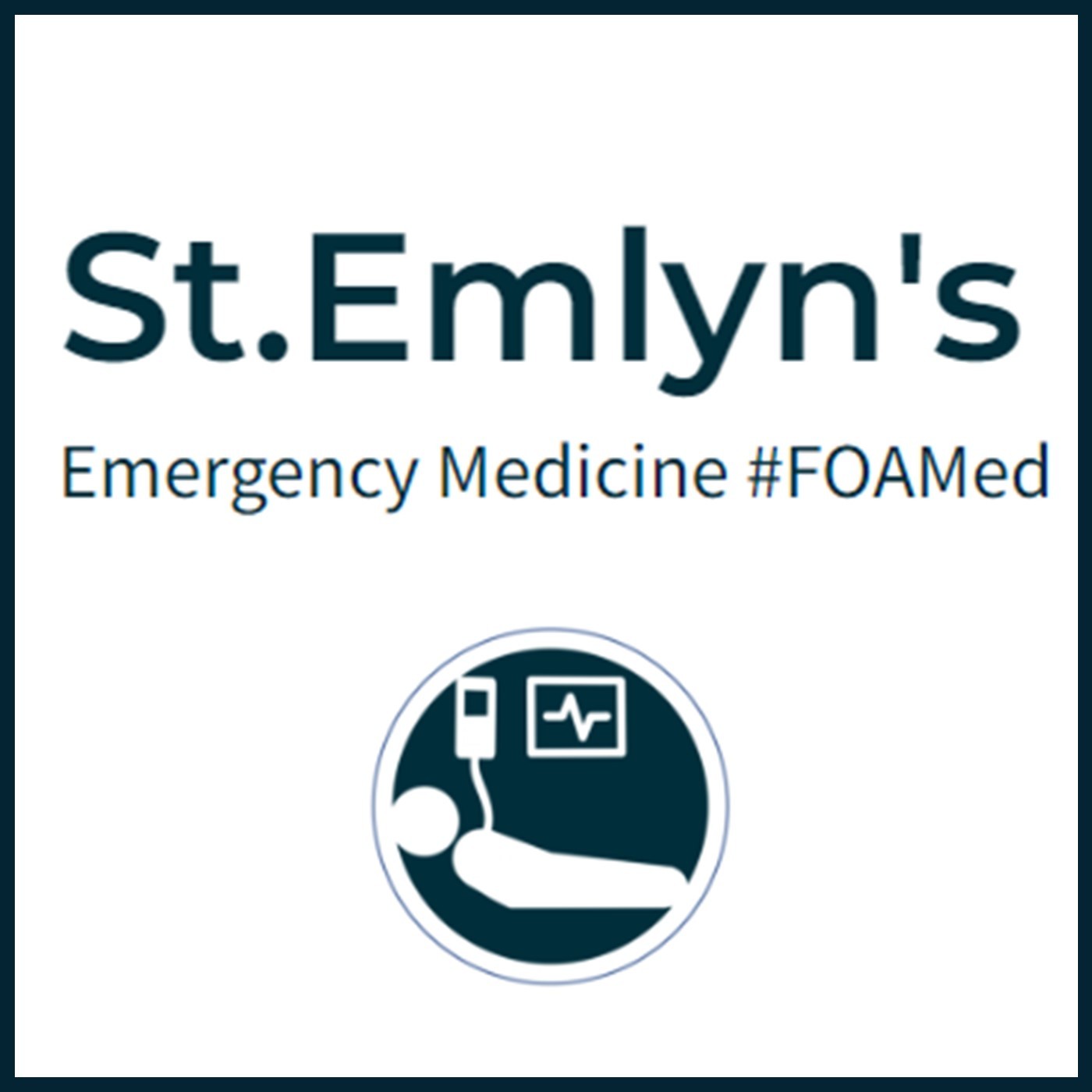
1.3M
Downloads
273
Episodes
A UK based Emergency Medicine podcast for anyone who works in emergency care. The St Emlyn ’s team are all passionate educators and clinicians who strive to bring you the best evidence based education. Our four pillars of learning are evidence-based medicine, clinical excellence, personal development and the philosophical overview of emergency care. We have a strong academic faculty and reputation for high quality education presented through multimedia platforms and articles. St Emlyn’s is a name given to a fictionalised emergency care system. This online clinical space is designed to allow clinical care to be discussed without compromising the safety or confidentiality of patients or clinicians.
Episodes

Thursday Mar 26, 2015
Ep 43 - APLS 2015 updates for the management of the serious injured child
Thursday Mar 26, 2015
Thursday Mar 26, 2015

A short podcast updating the UK Advanced Paediatric Life Support (APLS) course guidelines for the management of trauma in children.
Don't forget to read the blog post here. APLS Updates: New kids on the block,
vb
S

Sunday Mar 22, 2015
Ep 42 - Paediatric Major Trauma with Ross Fisher (LTC 2014)
Sunday Mar 22, 2015
Sunday Mar 22, 2015
Title: Rethinking Pediatric Trauma: Insights from the London Trauma Conference
Welcome to another insightful post from St Emlyns, where we dive into the latest discussions and research in emergency medicine. In this post, we recap a conversation with Rosfisher, a pediatric surgeon from Sheffield, who recently presented at the London Trauma Conference. Rosfisher shared his perspectives on pediatric trauma management, the challenges of research in this field, and the art of effective presentation. Let's explore these critical topics and their implications for emergency care.
Pediatric Trauma: A Unique Challenge
Pediatric trauma is an infrequent yet crucial area in emergency medicine, necessitating a distinct approach. Rosfisher emphasized that children are not simply "small adults." This fundamental concept underlines the need for specialized knowledge and skills when managing pediatric trauma. Despite the rarity of severe pediatric trauma cases, healthcare professionals must understand that children's anatomical, physiological, and pathological differences require tailored treatment strategies.
Understanding the Differences
One of the key points Rosfisher highlighted is the unique nature of pediatric anatomy and physiology. Unlike adults, children have different injury patterns, and their bodies respond differently to trauma. This distinction is crucial for emergency physicians, pediatric surgeons, and anesthetists, who must adjust their standard protocols to suit pediatric needs. The importance of recognizing these differences cannot be overstated, as it directly impacts the outcomes of pediatric trauma cases.
The Debate on FAST Scanning in Pediatric Trauma
A significant portion of Rosfisher's discussion focused on the use of Focused Assessment with Sonography for Trauma (FAST) in pediatric cases. While FAST scanning is a well-established practice in adult trauma, its efficacy in pediatric patients remains controversial. Rosfisher pointed out the lack of robust evidence supporting the reliability of FAST scans in children, citing a 50% sensitivity and specificity rate—equivalent to flipping a coin.
Limitations and Concerns
The concerns surrounding FAST scanning in pediatric trauma revolve around its diagnostic accuracy and the subsequent decision-making process. Rosfisher noted that even if healthcare professionals are skilled in using FAST scans on adults, this expertise does not necessarily translate to pediatric patients. The anatomical and physiological differences mean that the interpretation of FAST scans in children is more complex and less reliable. As a result, the decisions based on these scans carry a high risk of error.
The Role of CT Scans
In light of the limitations of FAST scanning, Rosfisher advocated for the use of computed tomography (CT) scans for pediatric blunt abdominal trauma. He referenced guidelines from the Royal College of Radiology, which recommend CT scans as the gold standard for imaging in these cases. The higher accuracy and reliability of CT scans make them a preferable option, providing clearer insights into the child's condition and guiding appropriate treatment.
Challenges in Pediatric Trauma Research
Pediatric trauma research is significantly underrepresented compared to adult trauma research. Rosfisher highlighted the stark contrast in research volume, with pediatric studies comprising less than half a percent of the total trauma research. This disparity poses a considerable challenge, as the lack of data hampers the development of evidence-based practices in pediatric trauma care.
Barriers to Research
Several factors contribute to the limited research in pediatric trauma. One major issue is the misconception that pediatric trauma is simply a scaled-down version of adult trauma. This oversimplification overlooks the complexities unique to children and the necessity for dedicated research in this area. Additionally, the relatively low incidence of pediatric trauma cases can make it difficult to conduct large-scale studies, further limiting the available data.
Opportunities for Growth
Despite these challenges, there is significant potential for growth in pediatric trauma research. The emergence of pediatric emergency medicine as a specialized field offers new avenues for research and development. Networks like PERUKI (Pediatric Emergency Research in the UK and Ireland) provide platforms for collaboration and innovation, encouraging more healthcare professionals to engage in pediatric trauma research.
Enhancing Presentation Skills in Medicine
Beyond his expertise in pediatric trauma, Rosfisher is passionate about improving presentation skills within the medical community. He argues that the way information is presented can significantly impact its retention and application. Many presentations, despite being rich in content, fail to leave a lasting impression due to poor delivery.
The Importance of Storytelling
Rosfisher advocates for incorporating storytelling into presentations. A well-structured narrative helps audiences follow the flow of information and retain key points. He uses the concept of an "arc of a story," similar to a plot in a film or book, to structure his talks. This approach ensures that the audience remains engaged and can easily recall the main message.
Practical Tips for Effective Presentations
For those looking to improve their presentation skills, Rosfisher offers several practical tips:
-
Know Your Content: Before delivering a talk, ensure you have a deep understanding of the subject matter. This foundation is essential for building a coherent and compelling presentation.
-
Elevator Pitch: Condense your talk into a brief "elevator pitch." If you can explain the essence of your presentation in 30 seconds, you are more likely to deliver a clear and focused message.
-
Audience Awareness: Tailor your presentation to your audience's needs and knowledge level. Understanding where your audience starts and where you want them to end up helps in crafting a relevant and impactful message.
-
Visual Aids: Use visuals to support your narrative. Rather than cluttering slides with text, use images and simple graphics that complement your spoken words and enhance understanding.
-
Consistency and Repetition: Start and end your presentation with the same message or visual cue. This technique reinforces the key takeaway and helps embed it in the audience's memory.
Case Study: Effective Use of Visual Aids
During his presentation at the London Trauma Conference, Rosfisher used several effective visual aids. He started and ended with the same video, challenging the audience to rethink their perspectives on pediatric trauma. He also employed a memorable device using the numbers 73 and 37, referencing the popular TV show "The Big Bang Theory." This consistent thread helped tie together various statistics and made the information more memorable for the audience.
Conclusion: A Call to Action in Pediatric Trauma
The insights shared by Rosfisher at the London Trauma Conference underscore the need for a nuanced approach to pediatric trauma. Recognizing that children are not small adults is a fundamental step in improving care and outcomes in this field. The discussions around the use of FAST scanning highlight the importance of evidence-based practices, while the challenges in pediatric trauma research call for greater investment and focus.
As healthcare professionals, it's crucial to continue exploring new methods and technologies, like CT scans, that can enhance diagnostic accuracy and treatment efficacy in pediatric cases. Moreover, by honing our presentation skills, we can ensure that vital knowledge and insights are effectively communicated, leading to better understanding and implementation of best practices.
In conclusion, pediatric trauma care requires a specialized approach, and the field offers numerous opportunities for research and innovation. We encourage our readers to engage with networks like PERUKI, contribute to research efforts, and continuously refine their skills, both in clinical practice and communication. Together, we can make significant strides in improving the care and outcomes for our youngest and most vulnerable patients.
Stay tuned for more insights and discussions from the St Emlyns blog, where we continue to explore the latest in emergency medicine and critical care. Don't forget to subscribe and follow us on social media for updates on our latest posts and podcasts.
Title: Rethinking Pediatric Trauma: Key Insights from the London Trauma Conference
In a recent discussion at the London Trauma Conference, Rosfisher, a pediatric surgeon from Sheffield, provided valuable insights into pediatric trauma care, the challenges of research in this field, and effective presentation techniques. This summary captures the key points from his presentations and discussions.
Pediatric Trauma: Understanding the Differences
Pediatric trauma presents unique challenges in emergency medicine. Rosfisher emphasized that children are not merely "small adults," a common misconception that can lead to inadequate care. The distinct anatomical, physiological, and pathological characteristics of children necessitate specialized approaches to treatment. Recognizing these differences is crucial for healthcare professionals, including emergency physicians, pediatric surgeons, and anesthetists, who must adjust their standard protocols accordingly.
The Controversy Around FAST Scanning
A significant portion of the discussion focused on the use of Focused Assessment with Sonography for Trauma (FAST) in pediatric cases. While FAST scanning is a well-established diagnostic tool in adult trauma, its efficacy in children is debatable. Rosfisher highlighted the lack of strong evidence supporting the reliability of FAST scans in pediatric trauma, citing a 50% sensitivity and specificity rate. This level of accuracy is akin to chance, making it a less reliable diagnostic tool for children.
The concern with FAST scanning lies not only in its accuracy but also in the potential consequences of basing clinical decisions on these results. Even experienced practitioners may struggle with interpreting FAST scans in children due to their distinct anatomical differences. As a result, there is a significant risk of incorrect decision-making. Rosfisher advocates for the use of computed tomography (CT) scans instead, as they offer more accurate and reliable imaging for pediatric blunt abdominal trauma. This recommendation aligns with guidelines from the Royal College of Radiology, which consider CT scans the gold standard in these cases.
Challenges in Pediatric Trauma Research
Research in pediatric trauma is significantly underrepresented compared to adult trauma research. Rosfisher pointed out that pediatric studies account for less than half a percent of all trauma research. This paucity of data presents a major challenge in developing evidence-based practices for pediatric trauma care. Several factors contribute to this lack of research, including the misconception that pediatric trauma is simply a scaled-down version of adult trauma and the relatively low incidence of severe pediatric trauma cases.
Despite these challenges, there is significant potential for growth in pediatric trauma research. The rise of pediatric emergency medicine as a specialized field offers new opportunities for research and innovation. Networks like PERUKI (Pediatric Emergency Research in the UK and Ireland) are fostering collaboration and encouraging more research in this area. Rosfisher emphasized the importance of starting with simple audit projects to assess current practices and gradually build a more comprehensive understanding of pediatric trauma care.
Improving Presentation Skills in Medicine
Beyond his expertise in pediatric trauma, Rosfisher is passionate about improving presentation skills within the medical community. He argues that the effective presentation of information is crucial for ensuring that important insights and knowledge are retained and applied. Often, the wisdom shared during medical presentations is lost due to poor delivery.
Rosfisher advocates for a storytelling approach in presentations. A well-structured narrative helps engage the audience and makes the information more memorable. He uses the concept of an "arc of a story," which involves structuring a presentation with a clear beginning, middle, and end, much like a film or book. This method helps the audience follow the flow of information and retain key points.
Practical Tips for Effective Presentations
Rosfisher offers several practical tips for improving presentation skills:
-
Master Your Content: Ensure a deep understanding of the subject matter. A technique like the "elevator pitch" can help distill the essence of a presentation into a concise summary, ensuring clarity and focus.
-
Audience Awareness: Tailor the presentation to the audience's knowledge level and interests. Understanding where the audience starts and where they should be by the end of the presentation is key to crafting an effective message.
-
Use of Visual Aids: Visuals should support the narrative rather than clutter the presentation with text. Images and simple graphics can enhance understanding and retention.
-
Consistency and Repetition: Using consistent themes and repeating key messages can reinforce the main points. For example, starting and ending a presentation with the same message or visual cue can help embed the information in the audience's memory.
Conclusion: A Call to Action in Pediatric Trauma
Rosfisher's insights highlight the need for a nuanced and specialized approach to pediatric trauma care. Recognizing the fundamental differences between children and adults is essential for providing appropriate treatment and improving outcomes. The debate around FAST scanning underscores the importance of evidence-based practices, while the challenges in pediatric trauma research call for increased focus and investment.
For healthcare professionals, engaging with research networks like PERUKI and contributing to pediatric trauma research are crucial steps toward advancing the field. Additionally, improving presentation skills can enhance the dissemination and retention of critical knowledge, leading to better clinical practices.
As we continue to explore and improve pediatric trauma care, we encourage our readers to stay engaged with ongoing research and professional development. Together, we can make significant strides in providing the best care for our youngest patients. Stay tuned for more insights and discussions from St Emlyns, where we continue to explore the latest in emergency medicine and critical care.

Sunday Mar 15, 2015
Ep 41 - Is trauma an elite sport? with Tom Evens (LTC 2014)
Sunday Mar 15, 2015
Sunday Mar 15, 2015
High-Performance in Trauma Care: Lessons from Elite Sports Coaching
Welcome to the St Emlyns blog! Today, we're diving into an insightful discussion from the recent London Trauma Conference, where Dr. Tom Evans shared his unique experiences and lessons learned from working with the British rowing team as a coach. Dr. Evans, a post-CCT doctor in emergency medicine and former Sydney HEMS doctor, offers a fascinating perspective on high-performance culture in trauma care, drawing parallels with elite sports coaching.
The Challenge of High Performance in Trauma Care
In trauma care, the term "world-class" is often used to describe top-tier performance. However, as Dr. Evans points out, this concept can be misleading. Unlike athletes who prepare for specific, well-defined events, emergency medicine professionals face an unpredictable array of cases daily. Thus, instead of striving to be "world-class," a more practical and applicable goal is to focus on achieving "high performance."
High performance is not an end result but a continuous process. It involves creating a culture where every team member is committed to doing even the smallest tasks as well as possible. This mindset shift from an outcome-based to a process-oriented approach is crucial for trauma teams, as it emphasizes excellence in everyday practice rather than sporadic peak performances.
High-Performance Culture: Key Components
-
Shared Mental Models: One of the key aspects of high-performance teams, both in sports and healthcare, is the creation of shared mental models. In coaching, athletes need a clear understanding of what their performance should look like. This clarity helps them execute their skills effectively under pressure. Similarly, in trauma care, standard operating procedures (SOPs) help create a shared understanding among team members. This reduces cognitive load and allows team members to anticipate actions and outcomes, leading to better coordinated and more effective care.
-
Simulation and Visualization: Dr. Evans emphasizes the importance of simulation and visualization in preparing for high-stress situations. Just as athletes use these techniques to mentally rehearse their performances, healthcare professionals can use simulation training to test and refine their responses to various scenarios. High-pressure simulations are particularly valuable as they help teams assess their readiness and make necessary adjustments to their mental models.
-
Marginal Gains and the Basics: The concept of marginal gains—small incremental improvements—is widely recognized in elite sports. However, Dr. Evans cautions against focusing solely on these gains without first mastering the basics. In trauma care, the foundational elements such as knowledge, systems, and debriefing must be solid. Marginal gains can only be beneficial when the team operates consistently at a high level. Therefore, trauma teams should prioritize getting the basics right before seeking minor improvements.
Training vs. Coaching: A Crucial Distinction
A critical insight from Dr. Evans is the difference between training and coaching. In medical education, training often focuses on imparting knowledge and passing exams. However, coaching is about enhancing performance and preparing individuals for real-world challenges. Coaches are invested in their athletes' performance outcomes and see success as tied directly to their athletes' achievements. This personalized and performance-driven approach contrasts with the often fragmented nature of medical training, where trainees rotate through multiple trainers and institutions.
Dr. Evans argues for a coaching approach in medical training. This would involve more personalized guidance and a focus on developing the skills and mindset needed for long-term success in the field. Such an approach could better prepare trainees for the unpredictable and high-stakes nature of trauma care.
Implementing High-Performance Strategies in Trauma Teams
To implement a high-performance culture in trauma care, several strategies can be adopted:
-
Institutional Support and Investment: High-performance training requires time and resources. Hospitals and healthcare institutions must prioritize training and development, even if it means adjusting schedules or reducing clinical productivity temporarily. This investment is crucial for cultivating a culture of continuous improvement and excellence.
-
Team-Based Training and Debriefing: Multi-specialty training and team-based exercises can help build a cohesive unit capable of high performance. Regular debriefing sessions after simulations and real cases are also essential. They provide opportunities for reflection, learning, and refinement of processes.
-
Focus on Human Factors: Understanding and optimizing human factors—such as communication, teamwork, and decision-making under pressure—is vital. Incorporating these elements into training and everyday practice can significantly enhance team performance.
-
Continuous Learning and Adaptation: The landscape of trauma care is constantly evolving, with new technologies and methodologies emerging. A high-performance team must be committed to continuous learning and adaptation, staying abreast of the latest developments and integrating them into practice.
Conclusion: A Call to Action for Trauma Teams
Dr. Tom Evans' insights offer a valuable perspective on achieving high performance in trauma care. By adopting strategies from elite sports coaching, trauma teams can cultivate a culture of excellence that prioritizes process, preparation, and continuous improvement. The shift from an outcome-focused to a process-oriented mindset, coupled with robust training and support, can lead to significant advancements in patient care and team effectiveness.
At St Emlyn's, we are committed to exploring innovative approaches to medical education and practice. We encourage our readers to consider how these high-performance principles can be integrated into their teams and institutions. Let's strive for excellence not just in the big moments but in every aspect of our work.
For more insights and discussions on trauma care, emergency medicine, and high-performance culture, stay tuned to the St Emlyns blog. Your feedback and experiences are always welcome, so feel free to share your thoughts in the comments below.
